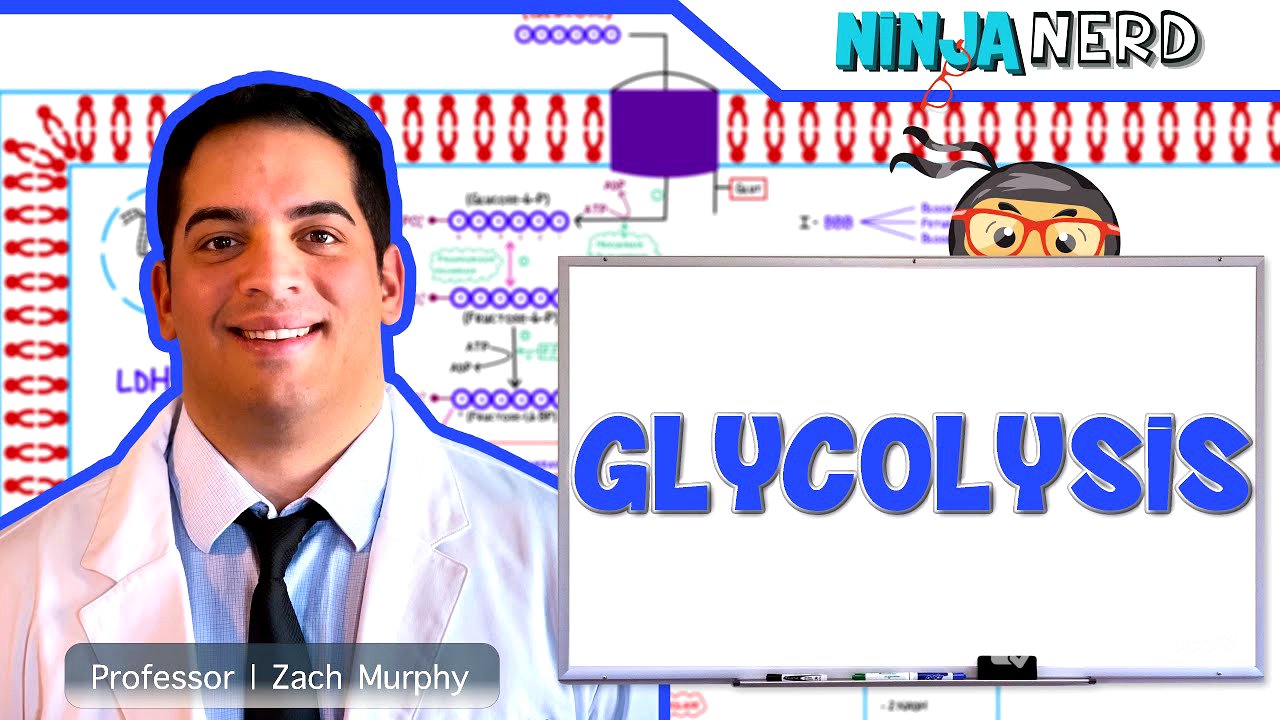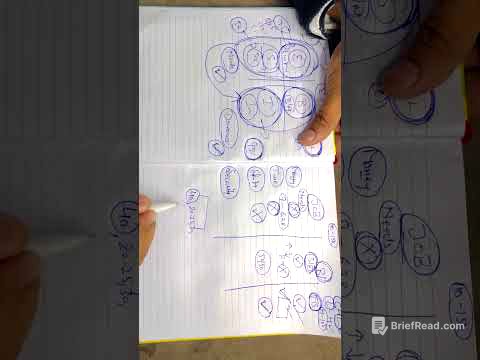TLDR;
This video provides a detailed explanation of glycolysis, the process of oxidizing glucose to produce pyruvate. It covers the various steps involved, the enzymes that catalyze these steps, and the different glucose transporters (GLUTs) responsible for bringing glucose into cells. The video also discusses the fate of pyruvate under both anaerobic and aerobic conditions, highlighting the production of lactic acid in the absence of oxygen.
- Glycolysis oxidizes glucose into pyruvate through a series of enzymatic steps.
- Glucose transporters (GLUTs) facilitate glucose entry into cells, with GLUT4 being insulin-dependent.
- The process occurs in the cytoplasm and involves a net production of 2 ATP and 2 NADH.
- Under anaerobic conditions, pyruvate is converted to lactic acid, which can lead to metabolic acidosis.
Intro and Overview [0:00]
Glycolysis is the process of oxidizing a six-carbon glucose molecule into two three-carbon pyruvate molecules. Glucose, obtained from our diet, is transported into cells where it undergoes approximately ten steps to be converted into pyruvate. The initial challenge is how to get the water-soluble glucose molecule across the cell membrane, which requires specialized transporters.
Glucose (Glut) Transporters [1:29]
Glucose, being water-soluble, cannot passively diffuse through the cell membrane and requires specific glucose transporters (GLUTs) to enter cells. These GLUTs are bidirectional, capable of moving glucose both into and out of the cell. There are several types of GLUTs, each found in different tissues: GLUT1 (red blood cells, fetus, blood-brain barrier), GLUT2 (kidney, liver, pancreas), GLUT3 (placenta, neurons, kidney), and GLUT4 (muscle, adipose tissue). GLUT4 is unique because it is insulin-dependent, meaning its activity and quantity are regulated by insulin levels, unlike GLUT1, GLUT2, and GLUT3, which are insulin-independent and regulated by glucose concentration.
Glucose-6-Phosphate [6:30]
Once glucose enters the cell, it is converted into glucose-6-phosphate by adding a phosphate group to the sixth carbon. This modification prevents glucose from exiting the cell, as GLUTs are bidirectional. The enzyme responsible for this conversion is either hexokinase (in muscles and other tissues) or glucokinase (primarily in the liver). This process requires ATP, which is converted into ADP, with the released phosphate attaching to the glucose molecule.
Fructose-6-Phosphate [10:20]
Glucose-6-phosphate is then converted into fructose-6-phosphate through isomerization, a reversible step catalyzed by the enzyme phosphohexose isomerase. Isomerization involves rearranging the molecule without changing its chemical formula, converting glucose (an aldose) into fructose (a ketose).
Fructose-1,6-biphosphate [11:40]
Fructose-6-phosphate is phosphorylated to become fructose-1,6-bisphosphate by the enzyme phosphofructokinase-1 (PFK-1). This step involves adding a phosphate group to the first carbon of fructose-6-phosphate, utilizing another ATP molecule, which is converted to ADP. This is an irreversible and highly regulated step in glycolysis.
Dihydroxy Acetone Phosphate / Glyceraldehyde-3-Phosphate [14:00]
Fructose-1,6-bisphosphate is split into two three-carbon molecules: dihydroxyacetone phosphate (DHAP) and glyceraldehyde-3-phosphate (G3P). This cleavage is catalyzed by the enzyme aldolase. DHAP is then converted into G3P by triose phosphate isomerase, as only G3P can proceed further in the glycolytic pathway.
1,3-biphosphoglycerate [17:24]
Glyceraldehyde-3-phosphate is converted into 1,3-bisphosphoglycerate (1,3-BPG) by the enzyme glyceraldehyde-3-phosphate dehydrogenase. This step involves the addition of an inorganic phosphate and the reduction of NAD+ to NADH. Since one molecule of fructose-1,6-bisphosphate yields two molecules of G3P, this reaction occurs twice, producing two molecules of NADH.
3-phosphoglycerate [20:30]
1,3-bisphosphoglycerate is converted into 3-phosphoglycerate by the enzyme phosphoglycerate kinase. During this step, a phosphate group is transferred from 1,3-BPG to ADP, forming ATP. Because this reaction occurs twice for each glucose molecule, two ATP molecules are produced.
2-phosphoglycerate [22:30]
3-phosphoglycerate is converted into 2-phosphoglycerate by the enzyme phosphoglycerate mutase. This step involves the shifting of the phosphate group from the third carbon to the second carbon.
Phosphoenol-pyruvate (PEP) [23:40]
2-phosphoglycerate is transformed into phosphoenolpyruvate (PEP) by the enzyme enolase. This conversion involves creating an enol structure with the phosphate group attached.
Pyruvate Kinase [25:25]
Phosphoenolpyruvate (PEP) is converted into pyruvate by the enzyme pyruvate kinase. This step involves the transfer of a phosphate group from PEP to ADP, forming ATP. Since two molecules of PEP are produced per glucose molecule, this reaction results in the production of two ATP molecules. This step is irreversible and highly regulated.
Anaerobic [27:10]
Under anaerobic conditions (low or no oxygen), pyruvate is converted into lactic acid by the enzyme lactate dehydrogenase. NADH unloads its hydrides onto pyruvate, regenerating NAD+ and forming lactic acid. Lactic acid can be transported to the liver to be converted back into glucose or used to produce ATP. However, lactic acid is acidic and can decrease blood pH, leading to metabolic acidosis. Elevated levels of lactate dehydrogenase in blood tests can indicate tissue ischemia or myocardial infarction, where oxygen delivery is compromised.
Wrap Up [30:55]
Glycolysis occurs in the cytoplasm of the cell, starting with glucose as the substrate and ending with two pyruvate molecules. The process yields a gross production of 4 ATP, but since 2 ATP are used in the initial steps, the net ATP production is 2. Additionally, 2 NADH molecules are generated. Under anaerobic conditions, the process leads to the production of lactic acid. In aerobic conditions, pyruvate is converted into acetyl-CoA, which enters the transition step for further energy production.









